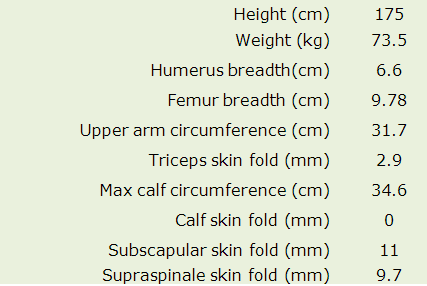14. "Somatotype" body shapes
In the 1940s a doctor called William Sheldon carried out some research which identified individuals in to three broad categories of body shapes which became known as "somatotypes" : the Ectomorph, the Mesomorph, and the Endomorph. Few individuals can be assigned purely to one category but a knowledge of your dominant characteristic may be helpful in optimizing a training plan. Sheldon believed that the somatotype was fixed throughout a person's life whereas later work done by Heath and Carter showed that the somatotype is more fluid and can be changed, for example, through athletic training. A very interesting somatotype chart can be found here : (https://mport.com/blog/know-your-body-type-somatotype/) which maps the somatypes to athletic potential.
The ectomorph is typically tall and lean and finds it difficult to gaining weight. Their low body fat composition means they have a high power to weight ratio, while their smaller surface area makes it easier for them to regulate body temperature and breathing more efficiently than mesomorphs or endomorphs. Ectomorphs therefore are potentially very suited to endurance sport such as long distance running.
The endomorph is the opposite of an ectomorph, typically with a large rounded frame that may be pear shaped. They carry much more weight of fat and muscle but may tend to accumulate fat if not careful with food intake or exercise. They can also gain fat and muscle relatively easily. Their high lung capacity makes them suitable for certain aerobic sports, such as rowing, and for strength activities such as power lifting or rugby.
Mesomorphs occupy the middle ground between ectomorphs and endomorphs. Typically they have a wedge shaped body with shoulders wider than the waist, and they are able to gain or lose weight easily. Mesomorphs have a classic athletic build that makes them suited to both cardiovascular and strength based sports.
Dr Sheldon's work on the physical aspects of these body types seems to have stood the test of time but he originally tried to associate personality traits with the physical aspects and that aspect has been debunked for a long time. My interest in somatotypes arose through reading about nutrition in training. From the physical description I was pretty sure I was a mesomorph and the article warned that mesomorphs should be careful to avoid too much carbohydrate and to eat more protein. Since that advice resonated with what I had found through personal experience, I decided to delve a bit further.
While you can make a pretty good guess as to your principal somatotype by looking in the bathroom mirror, there are a number of online calculators which allow you to input your own parameters. Somatotypes are rated numerically on a scale of 1 to 7. A pure ectomorph would be 7-1-1, a pure mesomorph would be 1-7-1, and a pure ectomorph would be 1-1-7, although in practice, we usually possess all three characteristics to some degree, even although one type will probably dominate.
I used this simple online calculator:
https://www.bodybuilding.com/fun/becker3.htm
which does not require much data, and it gave me a rating of 13% Ectomorph, 63% Mesomorph, and 25% Ectomorph which translates to :
0.91 Ectomorph : 4.41Mesomorph : 1.75 Endomorph
in the classical somatotype scoring. I am predominantly a mesomorph which is what I reckoned anyway from the visual descriptors.
If you want to while away an hour or two on with skin fold body calipers on a rainy day then you can achieve more accuracy if you Google "Eston's Somatotype Calculator" and download their Excel spreadsheet which implements the full methodology of Heath and Carter. This requires a lot more personal data because the Heath-Carter methodology calculates the body components using a mix of height, weight, lengths, various skin folds, and limb circumferences as follows :
The Ectomorphic component is calculated using only the body height and weight.
The Mesomorphic component is calculated using the body height, the breadth of the humerus and femur, the circumference of the upper arm, the triceps skin fold, the maximum circumference of the calf, and the calf skin fold.
The Endomorphic component is calculated using the triceps skin fold, the subscapular skin fold, and the supraspinale (aka the suprailiac) skin fold.
If you really want to understand the Heath-Carter methodology that underpins the Eston spreadsheet then download this document : http://www.somatotype.org/Heath-CarterManual.pdf, otherwise just make your measurements and feed them into Eston's calculator to get an instant answer. You need to make the measurements as accurately as possible, and at the correct locations on the body, but a Google search for "Heath-Carter + measurement type" will throw up lots of You Tube videos showing you exactly how to do it. Here are my measurements :
The Eston calculator determined my somatotype rating as :
2.04 Ectomorph : 4.54 Mesomorph : 2.25 Endomorph
which means that I am a "Balanced Mesomorph". Comparing that with the simple online calculator which rated me as 0.91/4.41/1.75 we can see the predominant value is almost identical whereas the other two values are under estimated slightly. However, given the effort of producing an accurate set of body measurements, and the relatively limited application of the somatotype rating anyway, I would recommend just using the simple calculator.

